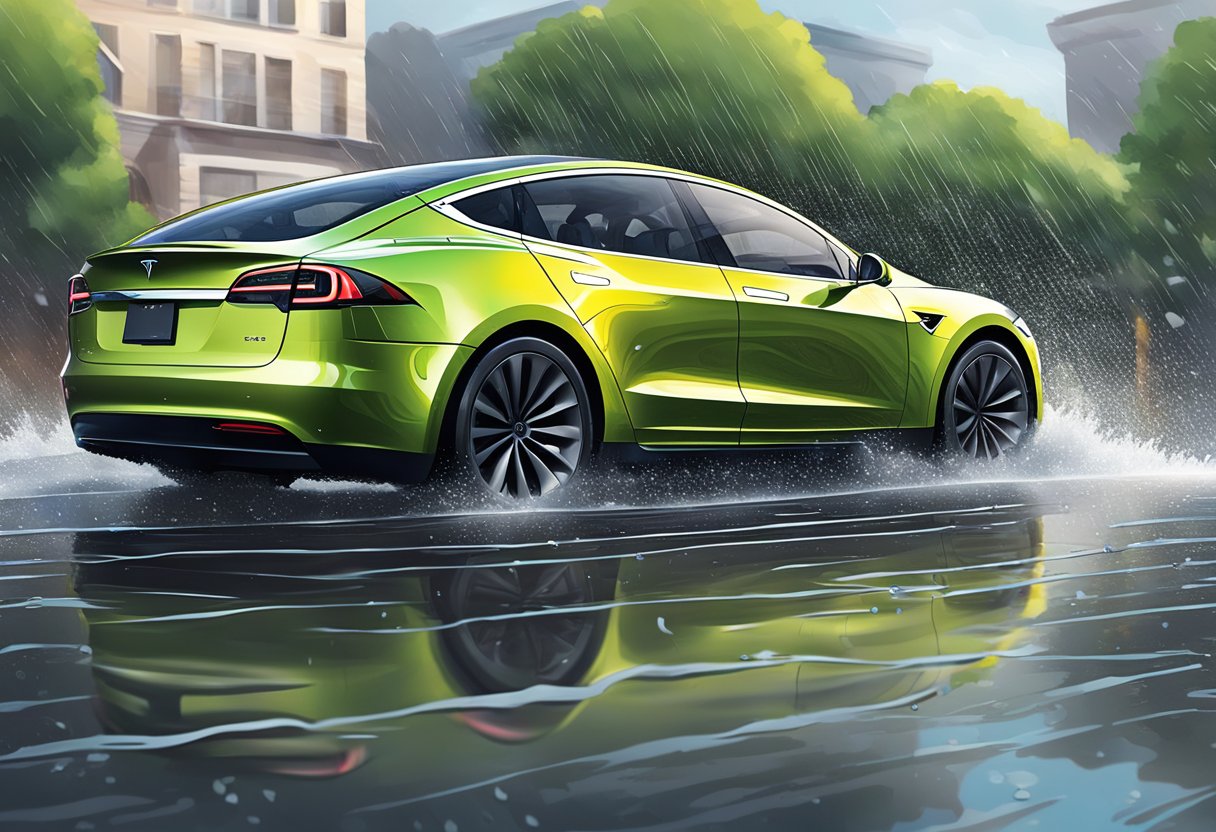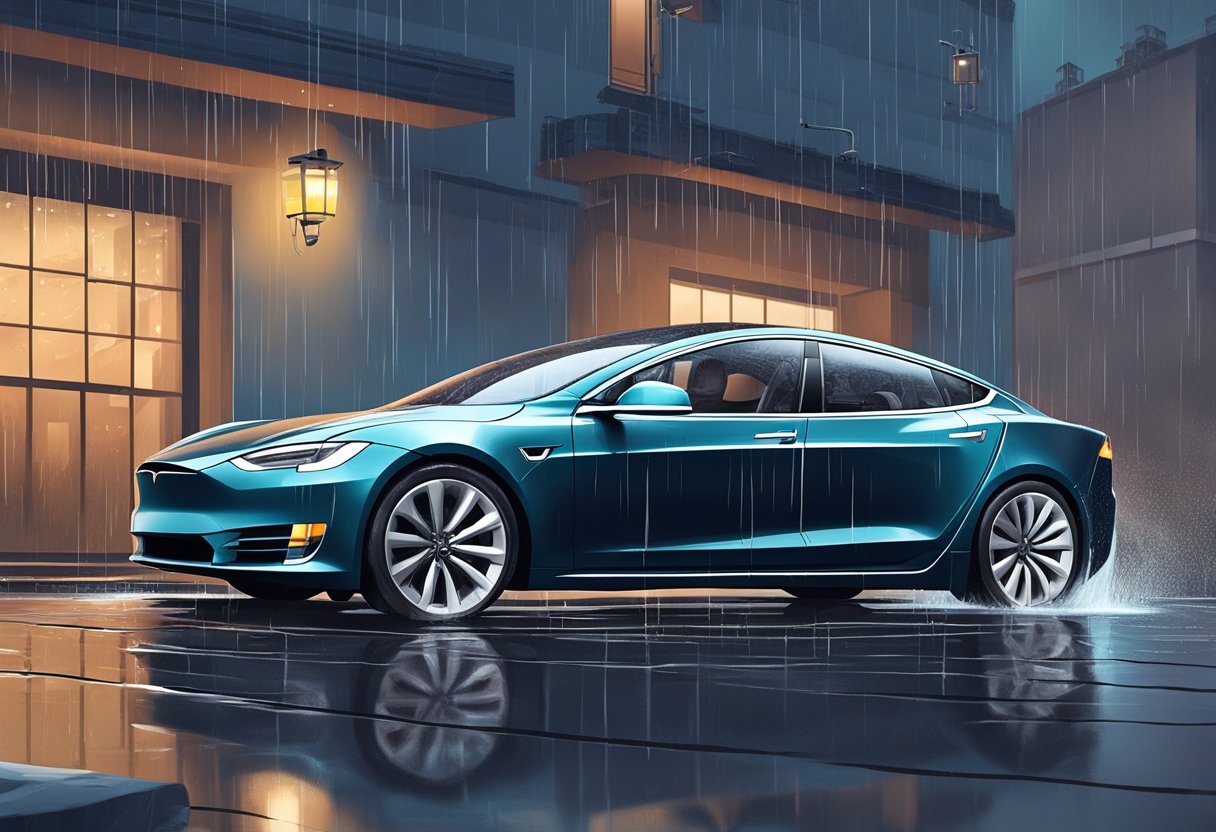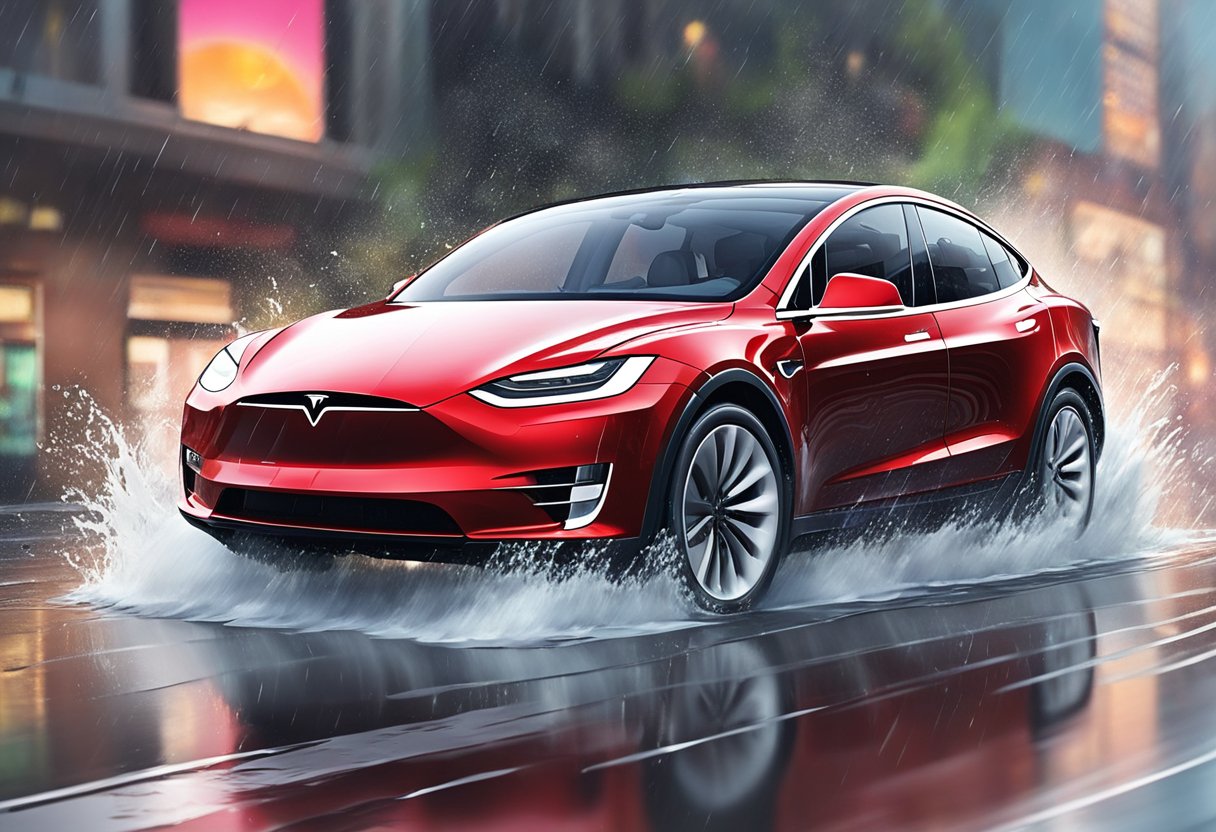When considering the purchase of an electric vehicle like a Tesla, one question that may cross your mind is whether these cars are waterproof. The mere notion of driving a vehicle filled with sophisticated electronic systems through water might seem daunting. It’s important to understand that while Tesla vehicles are designed to handle some exposure to water, such as rain and splashes, they are not classified as fully submersible vehicles.

The battery packs and the electrical systems in Tesla cars are well-protected and sealed against the elements. This means that driving through a puddle or getting caught in a rainstorm should not pose any immediate threat to the car’s functionality. Tesla has also made claims about the Cybertruck being able to temporarily float, hinting at its capacity to handle more than just light water exposure. However, it is imperative to remember that this does not equate to being completely waterproof, and taking a Tesla through deep water is not advised.
Understanding the limits of Tesla’s resistance to water is essential for maintaining the longevity and safety of your electric vehicle. While some experimental videos may show Tesla vehicles driving through water successfully, these instances do not reflect normal usage and could potentially void the warranty or cause damage not immediately apparent. Your Tesla can deal with water to a degree, but it is best to avoid intentional submersion or driving through high water levels to ensure the continued performance and safety of your vehicle.
Water Resistance and Tesla’s Design Philosophy
Tesla incorporates water resistance into its vehicle design, focusing on protecting the vital components from water damage. This is especially important for the electric vehicle (EV) drivetrain and battery pack to ensure your Tesla functions safely in various conditions.
Sealing and Vehicle Integrity
Your Tesla car’s structural integrity is enhanced with precise sealing techniques. Model S and Model 3, alongside other Tesla models, are built with a reinforced structure that includes seals at critical points to prevent water ingress. The doors, trunk, and other potential entry points for water are carefully sealed to mitigate the risk of water entering the vehicle’s cabin or vital parts of the electric system.
Tesla Battery Protection
The batteries in Tesla vehicles are designed with safety and durability in mind. Each battery pack is encapsulated within a sealed unit that includes a protective coating. This design helps to ensure that the battery remains safe from water damage, even when you drive through heavy rain. Tesla’s electric vehicles utilize a robust battery enclosure that protects against various elements, maintaining the integrity of the high-voltage components.
Driving in Wet Conditions and Floods
When you drive a Tesla, you’re engaging with advanced technology designed to handle wet conditions, but caution should be exercised during floods.
Performance During Heavy Rain
Your Tesla is equipped to perform admirably in heavy rain conditions. Windshield wipers engage automatically to maintain visibility, and the Electric Stability Control (ESC) system works in tandem with traction control to keep handling consistent. However, moisture can still affect range and driving performance, so it’s important to monitor your vehicle’s responses in such conditions.
- Tires: Ensure they have appropriate tread depth for wet roads.
- Autopilot: May be used in rain, but always stay attentive to intervene when necessary.
Tesla’s Capabilities in Floods
Teslas can handle shallow water, but driving through floods carries inherent risks. The vehicles are not designed to be underwater and water ingress can damage the motor and electrical systems.
- Doors: Keep them closed to prevent water from entering.
- Boat Mode: Not an official feature, so don’t rely on Teslas to navigate flood waters like a boat.
- After Floods: Always inspect for damage, particularly to high-voltage cables and components.
Remember: If you encounter a flooded area, it’s safest to find an alternate route.
Charging and Maintenance in the Face of Moisture

When owning a Tesla, understanding the interaction between water, particularly during charging and the overall maintenance routine, is crucial for the longevity of your vehicle’s vital components.
Charging Options and Safety
Tesla vehicles are designed to handle various weather conditions, including rain. However, it’s essential you follow best practices for safety and to prolong the life of the electrical components.
- Charging in Rain: You can charge your Tesla in the rain, as the vehicles and charging stations are engineered with safety in mind. The charging system includes mechanisms to detect short circuits and prevent water ingress.
- Charging Ports: Always keep charging ports dry and prevent prolonged exposure to moisture to avoid degradation of seals or other components.
Precautions for Charging in the Rain:
- Use waterproof charging equipment: Whenever possible, use waterproof charging solutions like a waterproof box.
- Protective Covers: Consider a waterproof cover for extra protection against the rain.
- Correct Connector Position: When not in use, hang the connector downward to prevent water from entering the charging port.
Routine Maintenance and Upkeep
Routine maintenance is crucial to ensure that your Tesla’s seals and battery life remain optimal, even when exposed to moisture.
- Battery and Seals: Regularly inspect the battery pack and door seals for signs of moisture and get them serviced as needed.
- Charger Maintenance: Keep your charger and its connections dry, and store it in a way that prevents water penetration.
Key Maintenance Tips:
- Regular Inspections: Look for any wear and tear in the charger and its cables, especially if regularly exposed to moisture.
- Service Intervals: Adhere to Tesla’s recommended service intervals for professional inspections to prevent any potential warranty issues.
- Professional Assessment: In case of suspected water damage, immediately seek a professional evaluation to prevent long-term damage to the vehicle’s electrical system.
Tesla’s Response to Water Related Incidents

Tesla vehicles have faced various water-related incidents, and the company’s response has varied from showcasing their resilience in floods to clarifying limitations via official guidance.
Cases and Tests of Water Incidents
In several cases, Tesla cars have been subjected to extreme water-related tests. Videos have surfaced showing Tesla vehicles navigating through flooded streets, with some owners and observers equating the vehicles’ abilities to a “boat mode.” Notably, in floods in Kazakhstan and Shanghai, Tesla vehicles were seen operating despite high water levels, raising questions about their water resistance.
In terms of official tests, there haven’t been clear disclosures from Tesla. However, numerous Tesla crashes and accidents in adverse weather conditions suggest that while vehicles may endure light flooding or heavy rain, various limitations still apply. These incidents serve as informal stress tests of Tesla’s seals and water ingress prevention measures.
Tesla’s Official Guidance and Warranty
Elon Musk has at times made claims on social media about the abilities of Tesla vehicles to handle water. According to Musk, Tesla can function as a boat temporarily, but this has not been presented as an official feature in any Tesla documentation or guidance.
The Tesla warranty provides more practical insight. The coverage explicitly excludes damage caused by water ingress, signaling that despite any informal tests or claims, water damage is a recognized risk. In the event of flood tests or other water incidents, the financial responsibility for any resulting damage to the battery or other components typically falls on the vehicle owner. Tesla’s warranty and guidance emphasize that while vehicles have various protective measures in place, they should not be intentionally driven through high water.
Your understanding of these responses and guidelines may influence how you navigate your Tesla through water-prone environments. It’s important to heed the manufacturer’s official guidance rather than anecdotal evidence of water resilience.

